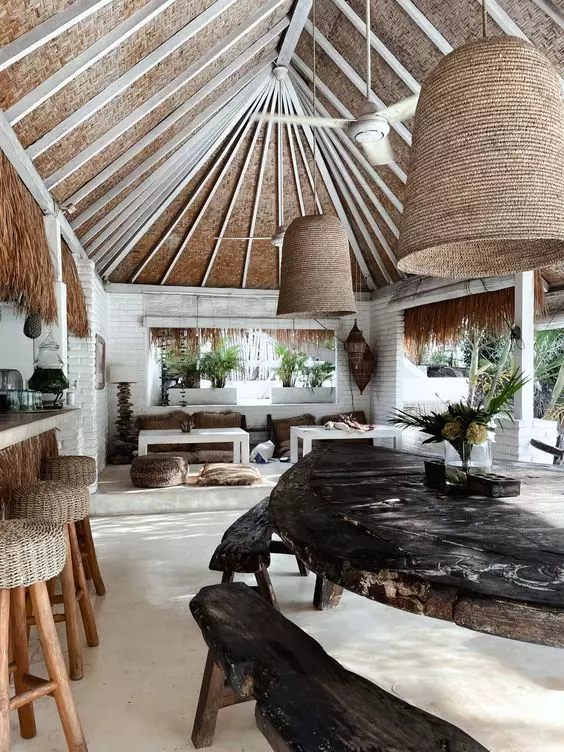If you're seeking to infuse your home with a touch of paradise, look no further than modern Balinese interior design. This trend effortlessly blends the tropical vibes of Bali with the clean lines and minimalist aesthetic of contemporary design. From bamboo furniture to natural fibers and textures, there are various ways to bring the beauty of Bali into your living spaces.
 Image credit: Pinterest
Image credit: Pinterest
The rise of Balinese interior design can be traced back to the early 1990s when architects and designers started experimenting with traditional Balinese architecture and elements. Influenced by the work of Made Wijaya, an Indonesian architect, who popularized the use of traditional Balinese culture in contemporary design, a new generation of designers emerged. Since then, Balinese interior design has gained massive popularity worldwide, as more individuals and businesses seek to create spaces that evoke the unique atmosphere of the island.
To incorporate Balinese beauty into your home or business, it is essential to grasp the fundamentals of traditional Balinese architecture and design. This knowledge will serve as the foundation for your own unique space. Additionally, don't hesitate to combine old and new elements, as traditional Balinese homes often integrate modern conveniences while still honoring their cultural heritage. Lastly, striking a balance between different elements is crucial for a successful Balinese interior design, achieving a sense of harmony in your space.
 Image credit: stirworld.com
Image credit: stirworld.com
Balinese interior design has gained such popularity due to various reasons. Firstly, it is undeniably beautiful. The intricate carvings, rich wood tones, and stunning fabrics contribute to an impeccable visual aesthetic. However, Balinese interior design has much more to offer. It is highly functional and comfortable, with spaces designed to flow seamlessly from one room to another, creating an open and airy feel. Thoughtfully positioned furniture maximizes space, promoting relaxation. Moreover, the use of natural materials like wood, stone, and rattan imparts a warm and inviting atmosphere to Balinese homes.
 Image credit: playoffside.com
Image credit: playoffside.com
Balinese interior design is characterized by specific key elements, rooted in traditional architecture. These elements contribute to its rich cultural influences, intricate craftsmanship, and a harmonious blend of traditional and modern elements.
Key Elements of Balinese Interior Design:
- Natural Materials: Balinese design incorporates natural materials such as wood, stone, bamboo, and rattan, adding warmth and a connection to nature.
- Wooden Furniture: Hand-carved wooden furniture with intricate detailing is a common feature, often using durable teak wood.
- Traditional Textiles: Batik and ikat textiles are widely used for upholstery, cushions, and curtains, known for their vibrant colors and intricate patterns inspired by nature and mythology.
- Open-Air Design: Balinese homes often blur the line between indoor and outdoor spaces, allowing for natural ventilation and a seamless connection to the tropical surroundings.
- Thatched Roofs: Traditional Balinese architecture features thatched roofs made from alang-alang grass, providing natural insulation while contributing to the overall tropical aesthetic.
- Balinese Carvings: Elaborate wood carvings depicting mythological figures, deities, or nature-inspired motifs can be found on furniture, doors, and decorative elements.
- Water Features: Balinese design frequently incorporates water features such as ponds, fountains, or small pools, bringing a calming and serene atmosphere.
- Stone Carvings: Balinese artisans showcase their skill in stone carving, adorning elements such as statues, wall panels, and garden features, adding elegance to the space.
- Balinese Art and Sculptures: Balinese art depicting religious or mythological themes enhances the cultural and spiritual ambiance of the space.
- Tropical Greenery: Lush tropical plants and greenery, such as palms and ferns, are essential to Balinese interior design, bringing the beauty of nature indoors.
- Warm Color Palette: Balinese interiors feature warm, earthy tones like browns, greens, and terracotta, creating a cozy and inviting atmosphere.
- Balinese Lighting: Lighting in Balinese design incorporates natural light during the day and warm, ambient lighting in the evening. Decorative lanterns, candles, and pendant lights with traditional designs are common.
 Image credit: italianbark.com
Image credit: italianbark.com
Color plays a significant role in Balinese interior design. White symbolizes purity and spiritual balance, while black represents wisdom and grounding. Additionally, red signifies energy and passion, and yellow represents prosperity and fertility. Green reflects nature, new beginnings, and growth. Balinese art also finds its place in interior design, with traditional paintings, carvings, and sculptures often used as decorations or focal points. These pieces often depict scenes from ancient Hindu epics like the Ramayana and Mahabharata. Traditional architectural elements, such as high ceilings, carved wooden beams, and columns, also frequently feature in Balinese interior design, creating a feeling of spaciousness and airiness.
 Image credit: bali-bungalow.com
Image credit: bali-bungalow.com
Furnishings in a Balinese home are typically simple, functional, and prioritizing comfort. Rattan or other natural materials are often used for sofas, chairs, and daybeds, accompanied by loose and comfortable cushions. Polished concrete flooring is a common choice as well.
 Image credit: wearedesignassembly.com
Image credit: wearedesignassembly.com
Are you ready to transform your home into a Balinese paradise? Incorporating natural materials is key. Opt for wooden furniture and décor, bamboo flooring and walls, and accentuate with stone elements. Utilize traditional Balinese textile techniques in your fabrics and rugs. Don't forget to add personal touches that reflect your love for the island culture.
 Image credit: bali-interiors.com
Image credit: bali-interiors.com
The Balinese interior design trend offers a unique and stylish option for modern homes. By combining traditional elements with contemporary style, you can create a space that is both beautiful and functional. Bring the paradise of Bali to your home by incorporating natural materials, neutral colors, and traditional elements to achieve a serene and culturally rich environment.
So, why wait? Start planning your own Balinese oasis today!

















